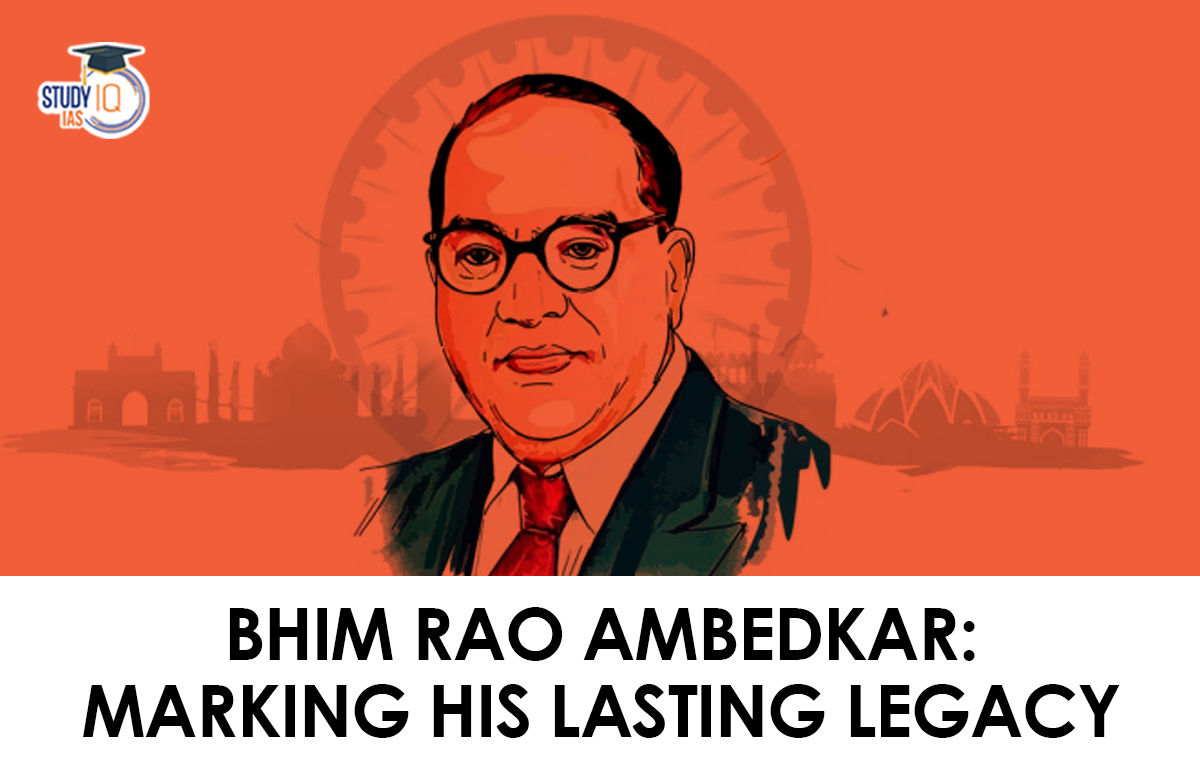Table of Contents
Context: April 14 is celebrated across India to mark Ambedkar Jayanti, the 132nd birth anniversary of Dr. Ambedkar.
About Ambedkar
- Bhimrao Ramji Ambedkar, popularly known as Babasaheb Ambedkar, was born on April 14, 1891, in the town of Mhow, Madhya Pradesh.
- As a child, he was “Bhim,” as he showed exceptional academic promise and he eventually became a jurist, scholar, economist, and great politician.
- Dr. Ambedkar was a vocal advocate for the rights of the Dalit community and campaigned against social discrimination through the Dalit Buddhist movement. He also fought for the rights of women and laborers.
Political Career of Dr. B R Ambedkar
- He founded the Independent Labour Party in 1936.
- He contested the 1937 Bombay elections through the party
- In 1946, he contested the Constituent Assembly of India elections but lost.
- Later, he was elected to the Constitution Assembly of Bengal.
- Dr. Ambedkar was an expert in the subject of the Constitution, having studied the Constitutions of 60 countries.
- He became the first Law Minister of India after independence.
- On August 29, 1947, he was elected Chairman of the Constitution Drafting Committee.
- As Chairman, he oversaw the drafting of the Indian Constitution.
- He is known as the Father of the Indian Constitution, for his instrumental role in shaping the country’s future and cementing its democratic values.
- He was conferred the Bharat Ratna posthumously in 1990.

Role of BR Ambedkar in India’s Struggle for Freedom
Social Reformer:
He actively challenged the discriminatory social practices through his speeches and writings, and his activism laid the foundation for the social justice movement in India.
- Fight Against Caste Discrimination in India: Ambedkar was born into the Mahar caste, a so-called lower-class community that faced discrimination. To counter this, Ambedkar led movements and marches to fight against the caste system.
- He fought for equal access to resources, including drinking water and religious worship, and led the burning of copies of Manusmriti in 1927.
- His social movement focused on instilling self-esteem, self-confidence, and self-respect among the lower castes, earning it the name “self-respect movement.”
- In the defense of Dalit rights, Ambedkar started five periodicals:
- Mooknayak (the leader of the dumb, 1920)’
- Bahishkrit Bharat (Ostracized India, 1924)
- Samta (Equality, 1928)
- Janata (The People, 1930)
- Prabuddha Bharat (Enlightened India, 1956)
Political Activist:
He played a vital role in the Round Table Conferences, where he advocated for the rights of the Dalits and other minorities. He also founded the Independent Labor Party, which later merged with the Congress Party. His key contributions include:
- Advocated for Separate Electoral for Dalits in the First Round Table Conference in 1930.
- Conflict with Mahatma Gandhi resolved by the Poona-Pact as discussed below.
- Believed that industrialization is necessary for the better development of the country.
- Argued that taxation should be based on the ability to pay rather than income, as poorer sections of society bear a greater burden.
- Proposed nationalization of entire agricultural area with collective farming to solve problems of small landholders and landless workers.
Educational Reforms and Women’s Empowerment
He founded the People’s Education Society in 1945 to promote education among all sections of society. He also played a crucial role in the establishment of the University of Mumbai and worked to make education accessible to Dalits and other marginalized communities.
- Contributions to Women’s Empowerment:
- Belief in Gender Equality: He strongly believed in equality and fought for women’s rights, including education, voting, marriage, and independence.
- Women’s Education: He recognized the lack of education for women as a major problem in Indian society and blamed Brahmanism for the misery of Indian women. He worked to implement compulsory education for children through Article 45 of the Constitution of India.
- Hindu Code Bill: The bill aimed to ensure gender equality and justice and was designed to move away from ancient orthodox laws. It granted women absolute rights to all property.
- Maternity Benefits: He recognized the importance of maternity benefits and maternal health for the dignity of women. He was a strong supporter of the maternity method and fought to ensure that mothers receive critical benefits.
Drafting of the Indian Constitution
- Ambedkar’s contributions to the Indian Constitution were fundamental rights, a strong central government, and minority protection. Article 32, which protects fundamental rights, was considered by him as the “spirit of the Constitution and its very heart.”
- He advocated for a powerful central government, as he believed that lower castes would be better protected by the national government than by municipal and provincial governments.
- He included various safeguards for minorities to protect them from the “Majoritarianism Syndrome” and ensure they had a share of power.
- The Indian Constitution is the world’s longest constitution because of the inclusion of administrative details.
Ambedkar’s Radical view on Caste
- He rejected the institution of caste itself, unlike Gandhi who advocated for abolishing untouchability only.
- Believed reformism by upper caste Hindus was inadequate to undo millenia of discrimination.
- Oppressed must reject their condition and oppression as divinely ordained before any revolt against the caste system is possible.
- Emphasized on lower castes obtaining political power.
- Suggested separate electorates as affirmative action to empower lower castes.
Arguments for Separate Electorates
- He believed that under separate electorates, each community would elect its own representatives, who would then advocate for their community’s interests.
- He argued that separate electorates would give the marginalized communities a voice in India’s political system and provide a means for them to participate in the governance of the country.
Ideological difference between Mahatma Gandhi and Dr. B.R. Ambedkar: Mahatma Gandhi and Ambedkar had significant differences in their approach to social justice and political representation. While Gandhi believed in the need to reform the caste system from within, Ambedkar argued for its complete eradication. Despite their differences, both leaders played an important role in India’s struggle for independence and the fight against social injustice:
- Gandhi’s Views on Caste: Gandhi believed that caste was a natural and necessary aspect of Indian society and that it had to be reformed from within. Gandhi’s views on caste were rooted in his belief that it was a religious and cultural issue that required a spiritual solution.
- Gandhi’s Opposition to Separate Electorates: Gandhi opposed the idea of separate electorates, arguing that it would further divide the country along caste lines. He believed that a unified electorate, where all citizens would vote together regardless of their caste or community, was the only way to achieve true national unity.
- Gandhi’s Alternative Proposals: Gandhi proposed an alternative to separate electorates, which he called the “Poorna Swaraj” or complete independence. He believed that India needed to achieve complete independence from British rule before it could address the issue of caste discrimination and untouchability.
The Yerawada Fast, Communal Award, and the Poona Pact
The Yerawada Fast
- In 1932, Dr. B.R. Ambedkar undertook a fast-unto-death protest against the British government’s decision to deny separate electorates to the Dalits. The fast took place at Yerawada Jail in Pune and lasted for seven days.
- As a result of the Yerawada fast, the British government agreed to grant separate electorates to Dalits under the Communal Award, which was announced in 1932.
The Communal Award
- The Communal Award was a policy introduced by the British government in 1932, which aimed to provide political representation to various communities in India.
- Under the Communal Award, the British government granted separate electorates to Dalits, Muslims, Sikhs, and other minority communities. The policy was opposed by Mahatma Gandhi, who saw it as a threat to national unity.
- The Communal Award was later modified through negotiations between Mahatma Gandhi and Dr. B.R. Ambedkar, resulting in the Poona Pact.
The Poona Pact
- The Poona Pact was an agreement signed between Mahatma Gandhi and Dr. B.R. Ambedkar in 1932. The agreement was a result of negotiations between the two leaders, following the introduction of the Communal Award.
- Under the Poona Pact, the British government agreed to provide reserved seats for Dalits in the provincial and central legislative assemblies, but without separate electorates. The reserved seats would be filled by Dalit candidates who were elected by a unified electorate.
- The Poona Pact was a significant achievement for Dr. B.R. Ambedkar, as it ensured political representation for Dalits in the legislature. However, the agreement was criticized by some Dalit leaders, who saw it as a compromise that did not go far enough in addressing the issue of caste discrimination.


 Daily Quiz 17 April 2025
Daily Quiz 17 April 2025
 Nilgiri Biosphere Reserve, Map, Climate,...
Nilgiri Biosphere Reserve, Map, Climate,...
 Complete List of Indian State Animals
Complete List of Indian State Animals





















